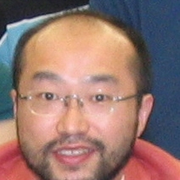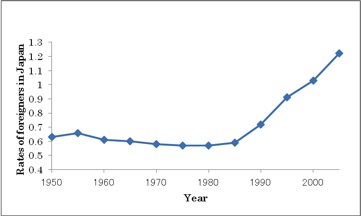Eiji YAMAMURA
Globalization and labour market in sumo wrestling
| Eiji Yamamura est professeur à l'université Seinan Gakuin (Fukuoka). Ses travaux de recherches relèvent de la socioéconomie, de l'économie industrielle, et de l'économie du sport . Auteur de nombreuses publications dont on peut citer les plus récentes: Mano, Y. & Yamamura,E. 2013. “Human capital accumulation through interaction within a married couple: comparison between a housewife and a working wife,” Forthcoming in Asian Economic Journal. Yamamura, E. 2013.“Public sector corruption and the probability of technological disasters” Economics of Governance, 14 (3), 233-255. |
 |
INCREASE IN IMMIGRATION IN JAPAN
In response to globalization, a number of researchers attempted to examine its influence on social and economic conditions. For instance, people’s attitudes towards immigrants are examined in Japan (Yamamura 2012). The ethnic composition of a locality seems to play an important role in determining attitudes toward immigrants. Looking at Figure 1 reveals that the rate of immigrants living in the country has risen consistently for the past 20 years although Japan can be thought of as a racially homogenous society. Inevitably, an investigation of individual attitudes and response toward foreigners will be increasingly important for the design of immigration policy in Japan.

FIGURE1
Rates of foreigners in Japan (%).
Source:http://www.stat.go.jp/info/kenkyu/kokusei/kankei/pdf/06sk.pdf (accessed Feb 25, 2009).
REVIEW OF SUMO WORLD
To take an interesting example of Sumo labour market, here I attempt to explore impact of globalization in Japan. In general, Sumo wrestling is regarded as a traditional fighting sport in Japan and has been popular since the 18th century. Due to the national isolation policy, Sumo wrestlers consisted of Japanese. However, after World War II, Sumo has become globalized. It is in 1968 that Takamiyama became the first non-Asian to reach the top division (makuuchi) in sumo. After a quarter of a century has passed, in 1993, the first foreign-born yokozuna (the highest rank in the top division) has emerged. Not only Takamiyama but also Akebono were born in the United States. Takanohana has retired in 2003. Since then, domestic Japanese wrestlers have never become yokozuna till 2013. That is, there has been no Japanese Yokozuna for ten years.
Differences in the labour quality of sumo wrestlers are thought to come from technical skill and physical strength. There is no weight category in Sumo. Therefore, an increase in weight might cause performance to be higher. The weight is thus considered to be human capital in the sumo labor market. In addition, foreign wrestlers such as Takamiyama and Akebono especially have a great advantage in terms of weight. “Upon their initiation into the sumo world, foreign wrestlers are already equipped with a physique equivalent to that of wrestlers in the top division. They have trained in American football or basketball, and have been excellent players.” (Nakajima 2003, 62).
EFFECT OF FOREIGN WRESTLERS ON JAPANESE ONES
In order to analyze the impact of emergence of foreign wrestlers, I constructed the records of 411 retired sumo wrestlers during the period 1945–2008. Based on the dataset, I found that 1) weight of Japanese wrestlers has increased drastically after emergence of foreign wrestlers, 2) an increase in weight did not lead to a higher winning rate and 2) an increase in weight raised the absence rate.
The findings imply that after an inflow of foreign wrestlers, over-weight wrestlers became more inclined to suffer injury and they did not have improved winning rates. To put in another way, an inflow of foreign wrestlers caused Japanese wrestlers to become over-weight, which in turn hampered performance. It is generally acknowledged that Sumo society has been governed by the traditional norm and Japanese wrestlers are therefore thought to put high value on traditions including the way of training. Japanese people are generally short and light-weight. Therefore, Japanese wrestlers are considered to have a comparative advantage in terms of agility. The basic economic theory leads me to predict that increasing competitive pressure naturally might lead Japanese domestic wrestlers to improve agility rather than increase weight. However, the outcome of globalization was quite different from it. The emergence of foreign wrestlers with a splendid physique misled domestic Japanese wrestlers to gain weight above their optimum level.
References
Nakajima T. 2003. Ozumo no Keizai-gaku (Economics of Sumo Wrestling). Tokyo: Toyokeizai Shimposha (in Japanese).
Yamamura, E. 2012. “Frequency of contact with foreigners in a homogenous society: perceived consequences of foreigner increases,” Japanese Economy 39(2), 37-48.
Yamamura, E. 2013. "Is body mass human capital in sports? Outcome of globalization of sumo wrestling and generation of human capital in Japan," MPRA Paper 44692, University Library of Munich, Germany.
NOTE
The argument of this note is mainly based on Yamamura (2013). See Yamamura (2013) if one would like to see estimation results and more detailed argument.
SaveSaveSaveSaveSaveSave |











